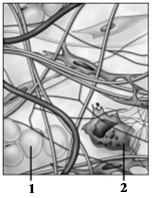The presence of water in our bodies allows us to
A. cool the body with sweat.
B. maintain a fairly constant body temperature.
C. provide an environment for chemical reactions.
D. keep tissues moist and reduce friction.
E. All of these choices are correct.
E
You might also like to view...
 A medical student is performing a dissection and wants to examine nervous tissue. Which of the following is not a good choice of structures for him to dissect?
A medical student is performing a dissection and wants to examine nervous tissue. Which of the following is not a good choice of structures for him to dissect?
A. Brain B. Intervertebral disc C. Vagus nerve D. Spinal cord
Bile salts function as digestive enzymes to break down fatty acids.
Answer the following statement true (T) or false (F)
Color blindness is a(n)
A) hereditary disease involving a lack of certain cones. B) nutritional disease related to a deficiency of vitamin A. C) progressive deterioration of the ganglion cells of the retina. D) inflammatory reaction causing damage to the photoreceptors. E) infection of the retina, resulting in destruction of the cones.
If the extracellular fluid (ECF) becomes hypotonic with respect to the intracellular fluid (ICF), which event will likely occur?
A) Water will move from the cells into the ECF. B) Metabolic generation of water occurs. C) Water will move from the ECF into the cells. D) The volume of the ICF will decrease. E) A large change in the osmotic concentration of the ECF occurs.